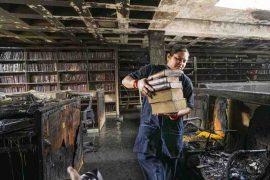Societies work tirelessly every year to put their best foot forward and perform at various colleges gaining a whole load of exposure and memories. But often these experiences come at the expense of one’s mental health and personal restrictions.
Even semesters at the University are jam packed with all kinds of events – dance, drama, debate and fashion, most notably college fests. And fashion events amongst them are considered the most glamorous of all – shows with extra spotlights, flawless garments and charismatic models. However, this screaming confidence on stage involves hours of practice and dedication, a fact most people tend to ignore.
What people also don’t realize is the untoward pressure, toxicity, shaming and biases that members of a fashion society deal with on a daily basis. They might be forced to follow certain diet restrictions, compromise on their personal life for the sake of endless practices and expected to deal with the toxic environments. You either adapt to this discomfort for your passion or end up leaving the society.
On the condition of anonymity, an ex-member of a renowned fashion society shares, “I was so thrilled to be a part of the fashion circuit in my first year. It seemed like the perfect start to my college life. However, it turned out to be so toxic right from the first week. The seniors who were so kind and considerate in the auditions were actually so rigid and egoistic when it came to following their instructions. One of them literally kept an eye on me to check how much time I spent having lunch. She not only scolded me for being just five minutes late to the practice but also didn’t shy away from passing personal comments. Because of their repeated misbehavior, I ended up leaving the society in the second week itself. But even after that they would talk nonsense about me and pass comments every time they saw me. I don’t know how much I have cried because of them.”
On the performing front, fashion productions often seem to be reduced to a mere display of ‘walk and entertainment’ and exquisite clothes with eve-teasing and name-calling during shows being recurrent occurrences.
DU Beat came across instances of the audience passing lewd comments from the crowd, throwing notes and papers at models on stage and clicking inappropriate pictures. This behavior is so uncalled for and affects the participating members mentally and emotionally. Societies have rightfully taken a strict stand against any such instance. However such shaming might not just be restricted to the crowd.
A member from a reputed girl’s college in South Campus talks about how fashion policing and judging is so normalized within the circuit. “You are expected to look presentable at all times, beyond the stage and practices as well. Because when it comes to shaming, even your society peers won’t leave a chance. I guess that is one reason why fashion societies are considered to be very elitist and that not everybody can afford the branded clothes and style. You are really judged on what you wear on a daily basis.”
It is usually assumed that fashion societies do not have much to do in terms of rehearsals and that it’s just about the ‘good looks and walking the ramp’. However preparing for this ramp walk involves costumes, dresses, props and lights that are designed and worked upon by the members themselves. The sequences are choreographed and repeatedly practiced. Moreover there’s a fine difference between a dance performance and a fashion walk. “Societies and judges continue to live on the tangent that drama and dancing makes a performance look good. But as a fashion society we work on our walk, props and expressions, not dancing around in carefully crafted costumes”, says Garima Satija, ex-president of Nakshatra, Hindu College.
“I went to a judge for the feedback of our performance at a competition. To my surprise the judge told me that we would have won if only we could add a bit of dance movements in the front. Most judges don’t even come from a fashion related background, they are sometimes dance choreographers or even faculty of the organizing college. While the judges’ decision is final and binding, we face problems in getting proper feedback for improvement. The true sense modelling and ramp walk seems to lack when people prefer dramatic content over pure fashion shows”, she added.
Many societies complain that the judges often end up giving vague explanations for feedback instead of valid points. With teams trying to uncover avenues of creativity in terms of themes and productions, there’s still no acknowledgement given to them for trying something out of the box because judges continue to consider the same old dramatic content to be capturing. Repetition of judges was a major concern pointed out by societies. A fashion society member from a North Campus college told DU Beat, “If a judge likes a performance at a particular college, they aren’t likely to change their views at another college and the same teams end up winning similar positions everywhere. The results get forged and the judges turn out to be explicitly biased towards certain societies. There isn’t any mechanism within the circuit as well to keep a check on this.”
Mismanagement at fest is another problem that societies put forth collectively. Events end up having logistical issues in terms of announcement of results, performing sequence, manipulation of results, untimely distribution of prize money and certificates and other malpractices. Such issues not only disheartening and difficult for the participants but also undermine the essence of performing art. With sensitive conditions in the city overlapping with the DU fest season earlier this year, many events were either cancelled or abruptly conducted. While societies did lose their chance to perform at maximum colleges, they also faced security issues while commuting and disappointment at many college doors.
A member of a South Campus society talks about a popular fest, “We faced a lot of security issues in the month of February and early-March. The gates were closed and the police were not permitting teams to enter the campus. The lack of coordination caused a lot of chaos and students were close to getting physically hurt. The organizers didn’t come to help the participants as they should have, and many had to return without performing.” He adds, “In fact after 9-11 teams clearing the prelims, they conducted their event with only 4-5 teams in the finals and eventually distributed the prizes as well. This was very unfair to teams who travel all the way to perform but cannot because of the inefficiency of the organizers.”
Addressing the show mismanagement issue, an ex-member of Poise, Institute of Home Economics, says, “Being an all-girls team we used to face security concerns due to varying show timings and late announcements of results. Shows hardly start on time and get delayed late for one another reason. With multiple shows in a day across colleges in the University, it becomes really difficult to manage it all and ends up affecting the performance of the team.”
Lack of green rooms and proper changing spaces is also an increasing concern within fashion societies. 15-20 members of a team are often clubbed into one small classroom and expected to change their costumes and assemble their props there. Sometimes the windows too are left uncovered. This leads to random people clogging outside these rooms, clicking absurd pictures and passing comments.
Talking about the rising bias and forged results in competitions, Aashna Rai, President of Galore, Maitreyi College tells DU Beat, “We’ve often witnessed judges repeatedly favoring teams which is highly demotivating for societies and the members. While every team deserves a fair judgement procedure, the scores and judgment sheets are not transparent at all events. They are often tampered by the organizers.”
She added, “At times societies copy the sequences, music track or garments of other teams causing internal feuds.”
Now building up an annual production does require extensive thinking and research. However in the process, societies often tend to forget the difference between inspiration and duplicity. Plagiarism thus leads to clashes and bad-mouthing within the circuit, thereby diluting its creative credibility.
While the internet is flooded over with body positivity content creators and inclusivity in modelling, the stereotype that a model has to have a good height and figure to enhance her looks still penetrates in the DU fashion circuit. Anushka Tyagi, the newest president of Nakshatra, Hindu College shares with DU Beat, “I have never won the ‘Best Female Model’ because I’m short and this is despite practicing my walk and expressions for hours with full dedication. In order to win an individual mention, you really need to look like a stereotypical model. It’s really hard to find judges who actually judge you on the basis of your confidence. Most of the time it comes down to looks, height and figure. With the circuit boasting flexibility in terms of body shape and height, you end up getting intimidated and insecure about yourself that you won’t ever be able to achieve something like that. I had to really push myself to come out of it and work on my sequence, energy and expressions with extra hard work.”
It’s time that the University circuits introspect its ways of functioning and develop mechanisms to deal with toxic environment, mismanagement and malpractices. Societies as a whole should come together to enable themselves to be friendly and respectful spaces that can promote collective growth and inclusivity. The true essence of any art form lies in upholding fairness with focus on performing instead of just winning.
Feature Image Credits: DU Beat
Aishwaryaa Kunwar
[email protected]




Comments are closed.